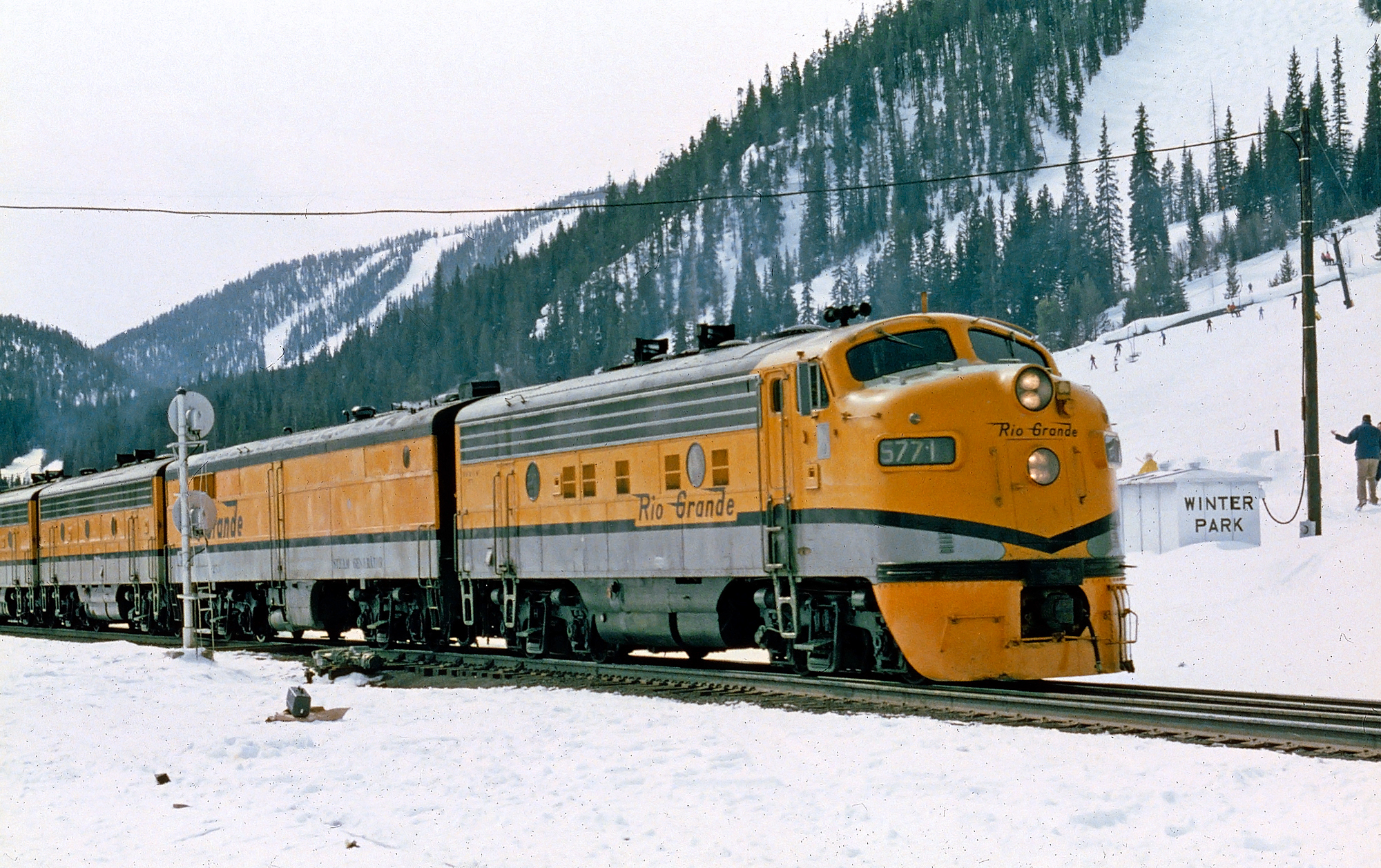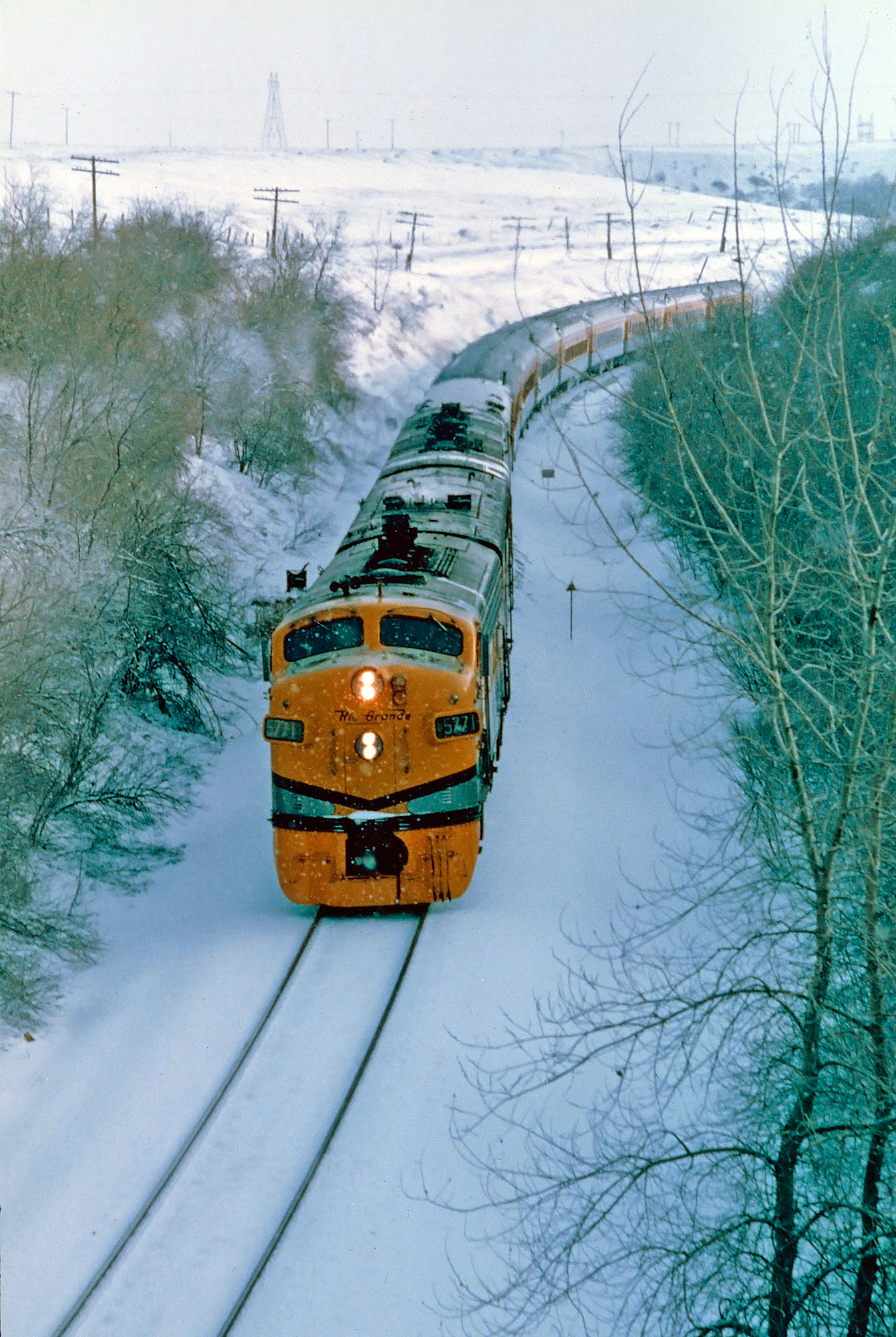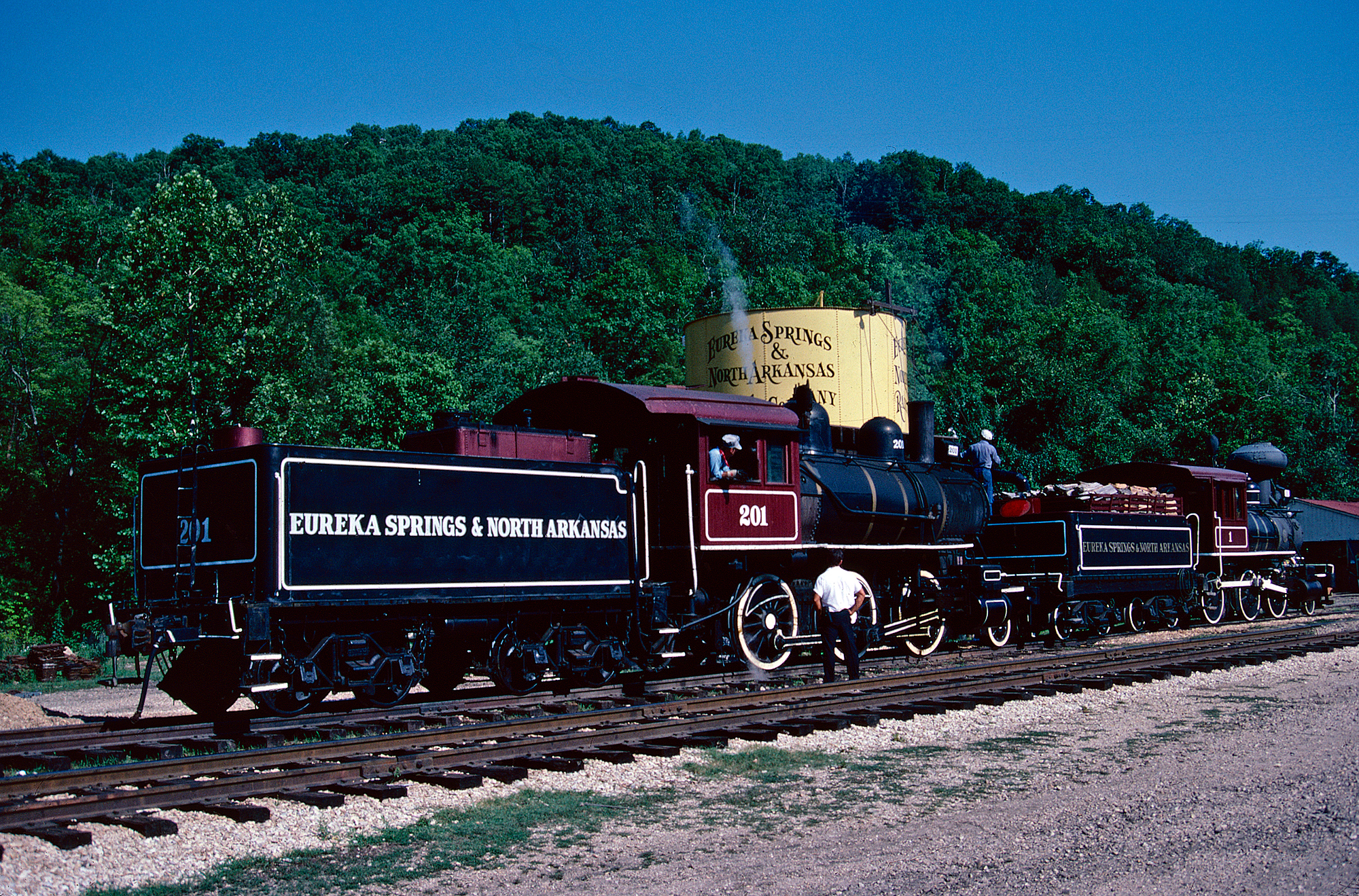The Ski Train (Denver-Winter Park): Route, Photos, History
Last revised: September 15, 2024
By: Adam Burns
One of the most unique services a private railroad ever offered was Rio Grande's Ski Train. It was launched in 1940 by subsidiary Denver & Salt Lake Railway, originally the Eskimo Ski Club's idea to whisk skiers from Denver to the slopes of Winter Park, a popular resort based in Grand County.
It was canceled in 1941 due to World War II but reinstated under the D&RGW in 1947. As its popularity grew, the railroad acquired eight heavyweight coaches (built in 1915) from Northern Pacific in 1960.
As time passed, the railroad tried numerous times to cancel the train due to rising costs. Today, this unique train lives on as the Winter Park Express, operated by Amtrak in conjunction with Union Pacific.
 Rio Grande F9A #5771 is ahead of the "Ski Train" at Winter Park, Colorado, circa 1984. Mike Bledsoe photo.
Rio Grande F9A #5771 is ahead of the "Ski Train" at Winter Park, Colorado, circa 1984. Mike Bledsoe photo.The Ski Train, now known as the Winter Park Express, holds a storied place in the realm of American rail travel and winter sports.
This rail service has a vibrant history rooted in the picturesque landscapes of Colorado, interfacing directly with the state's rich skiing culture. The service has evolved over decades, reflecting both technological advancements and shifting recreational trends.
The birth of the Ski Train dates back to 1940, during a period when rail travel was one of the most reliable means of long-distance transportation. The service was inaugurated to connect Denver, Colorado, with the burgeoning Winter Park Ski Resort.
This venture was more than just a transportation endeavor; it was a strategic partnership designed to foster a growing ski industry and provide accessible, efficient, and scenic travel for ski enthusiasts.
The initial journey was nothing short of spectacular. Skiers would embark on a day trip, leaving Union Station in Denver and arriving approximately two hours later at the base of the Winter Park Resort.
This was a golden era for train travel; the Ski Train offered a unique travel experience, where passengers could relax in heated cars, absorb the breathtaking views of the Rocky Mountains, and arrive at their destination invigorated and ready to hit the slopes.
The success of the Ski Train was immediate. It became an essential seasonal fixture, drawing not just local thrill-seekers but also tourists nationwide. The format of the service was finely tuned to cater to skiers' needs, running predominantly on weekends and holidays during the ski season, typically from late December to late March. The train’s popularity was bolstered by its convenience, avoiding the often treacherous winter road conditions leading to the resort.
Cultural and societal shifts in the mid-20th century presented various challenges to the Ski Train. The rise of the automobile industry and the Eisenhower Interstate System made personal car travel more accessible and popular. However, the Ski Train retained a dedicated clientele, thanks to its iconic status and the pleasurable experience it offered.
 Rio Grande's westbound "Ski Train," led by F9A #5771, is about to duck under the Highway 93 overpass west of Leyden, Colorado, circa 1983. Mike Bledsoe photo. American-Rails.com collection.
Rio Grande's westbound "Ski Train," led by F9A #5771, is about to duck under the Highway 93 overpass west of Leyden, Colorado, circa 1983. Mike Bledsoe photo. American-Rails.com collection.Despite numerous efforts to cancel the train over the years in 1984, new ownership under Philip Anschutz saw the purchase of updated equipment (second-hand cars from VIA Rail, originally built in 1968 by Hawker Siddeley). The Ski Train also occasionally ran with much fancier stainless-steel, Budd-built cars from the popular California Zephyr (and later Rio Grande Zephyr).
Ownership changes were also part of the Ski Train's journey. In 1988, the Rio Grande merged with the Southern Pacific, and subsequently, the SP was merged into the Union Pacific in 1996. Despite these changes, the essence of the Ski Train remained intact, maintaining its nostalgic charm and practicality.
In 1988, Ansco Investment Company, acquired rights to the train which continued to see strong patronage during the next two decades. Then, the service was suddenly canceled on March 29, 2009.
According to Trains Magazine's "Newswire," owner Philip Anschutz noted the rising insurance costs, operational issues in sharing the line with Union Pacific, and a weak economy led to the decision.
This hiatus was a period of uncertainty, marking the end of a 69-year continuous service and leaving a void for many loyal customers.
The winter of 2009-2010 saw a brief reprieve when a short-lived independent operation attempted a comeback.
In March of 2015, Amtrak and UP ran a one-day Winter Park Express ski train to celebrate the 75th anniversary of Winter Park. It quickly sold out and an additional service was hosted from from January through March, 2017. This was also successful and the train continues to run seasonally today.
This revival brought with it a modern touch while preserving the nostalgic essence of the original Ski Train. Amtrak introduced updated amenities and streamlined services, ensuring the journey remained seamless and enjoyable in line with contemporary standards.
The reintroduction was met with great enthusiasm and further complemented by the newly constructed heated train platform adjacent to the slopes, emphasizing convenience for passengers.
Today, the Winter Park Express operates from Denver’s Union Station to Winter Park Resort every weekend from January through March, along with a few select Fridays.
The journey, now approximately two hours long, remains a spectacular trek through rugged mountain terrain, featuring 31 tunnels, including the 6.2-mile-long Moffat Tunnel – an engineering marvel itself.
The modern incarnation of the service has been designed to appeal to a wide demographic, including dedicated skiers, snowboarders, families, and those simply looking to enjoy a scenic winter retreat.
The Winter Park Express's schedule thoughtfully balances the need for both early departures, allowing for maximum time on the slopes, and evening returns that grant a full day of skiing or snowboarding.
Furthermore, today's service underscores a commitment to sustainability. By providing an alternative to car travel, the Winter Park Express helps reduce the carbon footprint associated with mountain travel.
This aligns perfectly with broader environmental goals and the increasing awareness among travelers about the importance of eco-friendly tourism practices.
Looking forward, the Winter Park Express is more than a journey between two destinations; it's a bridge connecting history and modernity. It stands as a testament to the enduring appeal of rail travel and the deep-rooted skiing culture in Colorado.
The collaboration between public and private sectors, organizational adaptability, and technological advancements have all played a crucial role in sustaining this iconic service.
In summary, the evolution from the historic Ski Train to the modern Winter Park Express encapsulates a rich tapestry of American rail history, innovation, and recreational culture.
It is a vivid reflection of how tradition can be preserved while embracing modernity, ensuring that future generations continue to enjoy this unique travel experience.
Whether for the nostalgic train enthusiast or the modern-day adventurer, the Winter Park Express promises a ride through both a timeless past and a vibrant present, all set against the stunning backdrop of the Rocky Mountains.
Recent Articles
-
Arizona Railroad Museums: A Complete Guide
Apr 16, 25 01:17 PM
Learn about Arizona's rich history with railroads at one of several museums scattered throughout the state. More information about these organizations may be found here. -
Arkansas Railroad Museums: A Complete Guide
Apr 16, 25 12:59 PM
The state of Arkansas is home to a handful of small railroad museums. Learn more about these organizations here. -
Alabama Railroad Museums: A Complete Guide
Apr 16, 25 12:30 PM
Alabama, with its storied past and vibrant connection to the railroad industry, is home to several captivating railroad museums.

